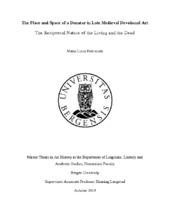| dc.description.abstract | The first part of this study investigates the supplicants’ relations and interactions based on their position within an artwork. I analyze the importance of being visible and its connection with the act of devotion, as the space that the donor is occupying and sharing with the other depicted figures. I try to find the patterns and the rules governing the ways in which the commissioners are portrayed. To illustrate this aspect, I will use the concept of memoria and care for the here and the hereafter as well as its connection to the donor’s appearance. It is a three-way relation, a kind of pattern of influence where there is a supplicant, a regular churchgoer who is a spectator, and God himself. In the second part of my thesis, I to focus on the commissioners’ place in the society and the significance of being seen not only as a pious but also as a noble, rich and powerful person. The way in which donators attempted to present themselves, both for the here and the hereafter, apparently played a significant role in the medieval devotional art. The third part approaches the question of donators’ visibility for the sake of their salvation. The issue examined is how being a part of sacred narratives influence the time spent in Purgatory and all the actions the donators took in order to be seen. They wanted to be visible, remembered and prayed for. Furthermore, I will present the discussion related to the terminology of patronage in Medieval Art studies. The analysis conducted shows that being visible is strictly connected with the desire of salvation. Depiction, position, place and space of the figures is deeply related to care for the here and the hereafter and the necessity of being close to God hereafter is stronger than vanity in here. | en_US |
